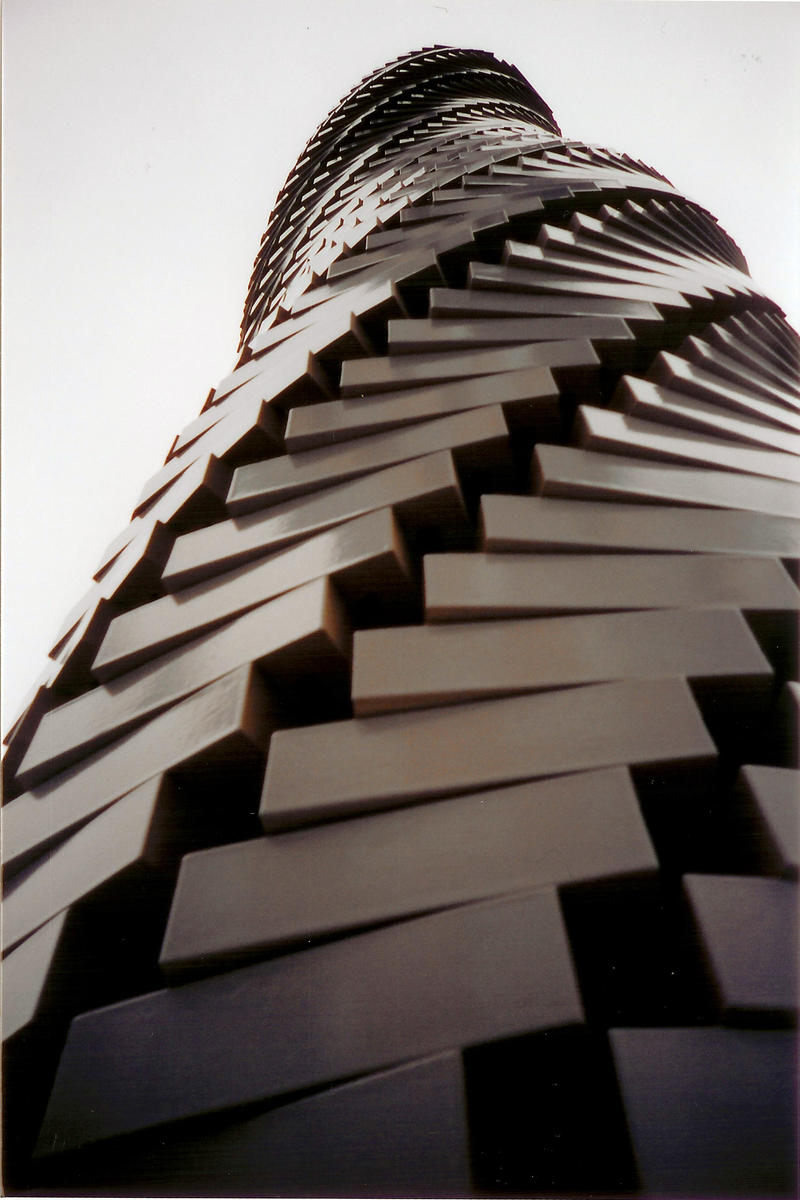
Shirazeh Houshiary’s latest project Breath, a collaboration with architect and husband Pip Horne, climbs up out of the stone plaza in front of the Ritz-Carlton Hotel, Battery Park in Lower Manhattan. The work echoes Houshiary’s recent delicate drawings and video work. Her grids, which have a presence that elegantly suggest vaporous breath and activities on the cellular level of life, are made solid in a twenty-foot tall tower of enameled bricks with a humming soundtrack that resonates from within its interior. The masterfully engineered column is made to resemble the twisting double helix of DNA, among other things, while the soundtrack loops four different religions’ spiritual invocations together.
In the context of Battery Park, the intended message about the basic similarities of humanity is apparent almost immediately. In front of the sculpture, the park offers views of Ellis Island and the Statue of Liberty while the eternal flame commemorating September 11th is a block away. These monuments provoke an instant feeling of compassion and set a contemplative tone for the park and for Breath. While the sculpture’s message relating shared experience peters out with a disappointing kind of “can’t we all just get along” feel, the most interesting aspect of the project is the path it traces through different geographies, religions and public and private worlds.
Houshiary’s choice of source material for the audio of the sculpture helps to define this space. Spiritual music from Islamic, Jewish, Buddhist and Christian traditions reference not only the specific religions, but also gesture generally toward various geographies. The songs also traverse public and private space. The most public is the Azan, the Islamic call to prayer which is broadcast from speakers from the tops of mosques five times a day in places as disparate as Amman, Jordan and Hamtramck, Michigan. The most private is the Buddhist monks’ tonal breathing exercises—an almost completely personal and internal expression of meditation. The other two songs, the Jewish tribute to the invisible god and “O Jerusalem,” a historical Christian chant by 12th century nun Hildegard von Bingen (a song that often shows up on New Age Gregorian chant compilation CDs), fall somewhere in between the two extremes. Both are “public,” though within much more intimate contexts than the Azan.
The subtly undulating column itself is a conceptual armature waiting for a range of meanings to be hung on it. Its form calls to mind not only the double helix, but also the surrounding buildings, a smoke stack lifted from a boat in adjacent harbor, the pillars of a Baroque cathedral’s baldacchino, or an ancient Greek column with a narrative frieze spiraling up the body of the column. With this last reference, the sculpture opens up another side of itself.
It seems when New York’s preeminent nonprofit public arts presenter, Creative Time, curated this round of their Art on the Plaza sculpture series at the Ritz-Carlton, they intuitively channeled the original Ritz. Paris’s Ritz Hotel sits at the corner of Place Vendôme, a plaza whose focal point is a 140 foot column erected by Napoleon to commemorate his continuing invasion of Europe. Its spiraling frieze depicts the story of France’s conquests. So from Place Vendôme to Battery Place, Paris’s monument celebrating its empire is recast as a call for humanity from the epicenter of a globalizing country.
Houshiary’s abstract drawings evoke a range of references without overstating their influences. Yet this delicate ambiguity is trampled when the references become so specific. Stacking basic geometries hummed with symbolic subtext in her past sculptures, even without a soundtrack. With Breath, the subtext becomes deafening.
Breath is presented by Creative Time, World Financial Center Arts & Events Program, The Ritz-Carlton Hotel and The Hugh L. Carey Battery Park City Authority (BPCA) and is on view until January 2005.
